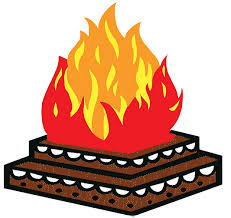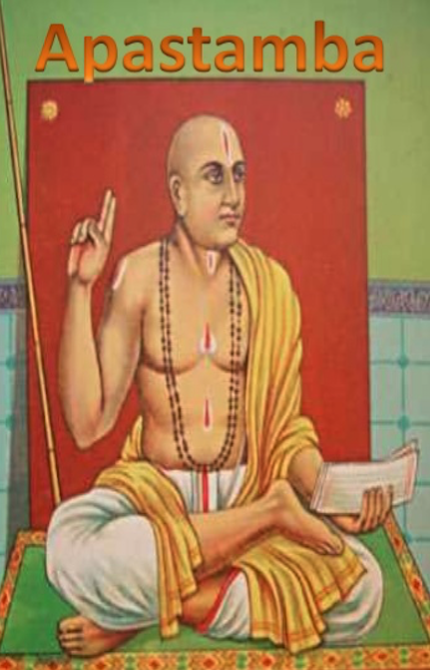We learn subtle matters that are invisible to us through scriptures. We follow as ordained by scriptures and benefit accordingly. Hence scriptures are the pramAnam. We are called as Vaidikas as we follow the rituals ordained by the scriptures. Scriptures are the root source for all the rituals. If we could not get a clarity from them, we seek other Smriti (Upanishads) to perform rituals.
Smritis are written by Rishi-s. These Saints wrote the Smritis out of divine grace of Bhagavan as a fruit for their rigorous penance. The Smritis that are written by such satvic saints are the proof for our Vedic matters. Abasthambar is one such satvic saint. He has written granthams like Sraudham, Gruhya sutram and Dharma sutram. Sraudham talks about religious rituals, Gruhyam talks about upanayanam and wedding rituals.
While paying obeisance to the the elders, one chants “apastambha sutra:” such is the greatness of Apastmbha Maharishi. In fact, Saint Bodayana comes only after Apasthambar. This saint had acquired the name Apastambhar for a reason. His wife was called as Akshasutra and he had a son named Kalki. During his period, there was another devout Brahmin who followed the ordained rituals strictly. While performing annual oblation for his parents, this brahmin use to appoint a well learned Vedic brahmin to perform Nimantranam for concluding the oblation. On one such occasion, he could not find any suitable person to complete the Nimantranam so he invoked a suitable brahmin on a koorcham, as per the scriptural law this process is called ‘satakam’ and went on to complete the ceremony.
 Saint Apastambhar wanted to teach this brahmin the truth of the scriptures, so he took the form of a old brahmin and reached his place right on time. Apastambhar thought ‘a brahman is the one who learns Brahma Gayatri from his preceptor and chants it as ordained is considered pious even if he has not learnt any other sastra.’ Such a brahman is eligible to do Nimantranam during the oblation. The saint’s objective was to propagate the glories of Gayatri japa Anushtanam to the world. This learned brahmin happily received the saint and requested him to do the Nimantranam. Everything went well, after partaking the food, the Karta of the ceremony carried prasadam in one hand and water to be poured in other hand and asked the saint ‘triptosi’? (are you happy with my service) for which the saint in the form of brahmin replied please ‘serve me some more rice and curds’ the performer obliged and asked him again are you contended for which the saint again asked him for another serving of the same. The srardha karta was furious, he said if he serves such a person, performing an oblation like this would be a waste. Saying so he threw away the water holder. The saint out of his power of penance made the water stand still from the water holder as spilling of water from the holder will lead to sin. The srardha karta realised the greatness of the saint and offered his profuse apologies.
Saint Apastambhar wanted to teach this brahmin the truth of the scriptures, so he took the form of a old brahmin and reached his place right on time. Apastambhar thought ‘a brahman is the one who learns Brahma Gayatri from his preceptor and chants it as ordained is considered pious even if he has not learnt any other sastra.’ Such a brahman is eligible to do Nimantranam during the oblation. The saint’s objective was to propagate the glories of Gayatri japa Anushtanam to the world. This learned brahmin happily received the saint and requested him to do the Nimantranam. Everything went well, after partaking the food, the Karta of the ceremony carried prasadam in one hand and water to be poured in other hand and asked the saint ‘triptosi’? (are you happy with my service) for which the saint in the form of brahmin replied please ‘serve me some more rice and curds’ the performer obliged and asked him again are you contended for which the saint again asked him for another serving of the same. The srardha karta was furious, he said if he serves such a person, performing an oblation like this would be a waste. Saying so he threw away the water holder. The saint out of his power of penance made the water stand still from the water holder as spilling of water from the holder will lead to sin. The srardha karta realised the greatness of the saint and offered his profuse apologies.
Apastambhar gave many upadesams to the brahmin like one should be devoid of anger particularly while doing rituals. As per the statement ‘Gayantam trayate iti Gayatri,’ Gayatri Devi protects the chanter of Gayatri mantra from all sins. One who chants Gayatri as ordained is eligible to perform Nimantranam during oblation. It is not right to invoke brahmins on a grass. The learned brahmin did not have the right knowledge on sastrams. He realized his folly, offered due apologies and concluded the ceremony.
He was called Apastambhar because he made the water stand still in the holder itself. This story also tells us to control anger and to respect the chanters of the glorious Gayatri Japa.
(Sri U.Ve Atti Krsnamacarya Swami Tirupathi)
To read the above article in Tamil, please visit Apasthambar









Dear Jayashree madam,
Many thanks for the wonderful story on Sage Sri Apasthambha.
Adiyen would like to share few thoughts on this article.
1. The Maha Rishis did not ‘write’ the smrithi – they only had the ‘divya drishti’ of the Vedic Mantras – which are ever present. That’s why they are called ‘Mantra Drushtaas’, one who ‘sees’ the mantra. Even Sage Veda Vyasa, who ‘compiled’ the vedas into the 4 branches, did not ‘write’ the Vedas – he, with his Vedic knowledge and yogic vision, split the Vedas, which until then were learnt as one single body of knowledge together, into 4 Vedas as Rik, Yajur, Sama and Atharva Vedas and gave it to his 4 disciples who formed the various shaakas or branches further dividing the Vedas to their disciples in succession.
2. Maharishi Uddalaka informs his son Swetha Kethu – that there will be Maharishis who have the potential to have the ‘vision’ of Vedas only till the Dwapara Yuga. In Kali Yuga, there will be no one as ‘Maha Rishi’ – even if they are able to achieve such Rishi states through their past birth austerities, they will not be called ‘Maha Rishis’ but only as great sages. Sage Sri Apasthambha is not a Maha Rishi – though we respectfully call him as ‘Apasthambha Maharishi’. He mentions himself that he is following the lines of earlier Maharishis and not including anything new in his Apasthambha Sutras.
3. Whether Apasthamba is before Bodhayana is debatable, Bodhayana’s sutra’s shraadha karma are even more elaborate. Many of the strict rules in Bodhayana are not seen in Apasthambha. Also Bodhayana sutra followers are mostly from North of Narmada and Apasthambha sutra followers are mostly from south of Narmada river.
4. The story of how Sri Aapasthambhar made the Vedic Brahmin realize the greatness of the Brahmin who chants Gayatri properly after proper initiation and the advise that Brahmins should never get Angry that too specifically during the Shraadha rituals or while offering food to other Brahmins is very great information. Apt for today’s world where people use abusive language just a the drop of a hat..
Thank you.
Adiyen,
Sri Ramanuja Daasan – Vijayaraghavan
Respected Swamin
Many thanks for the insightful reply.
Adiyen.